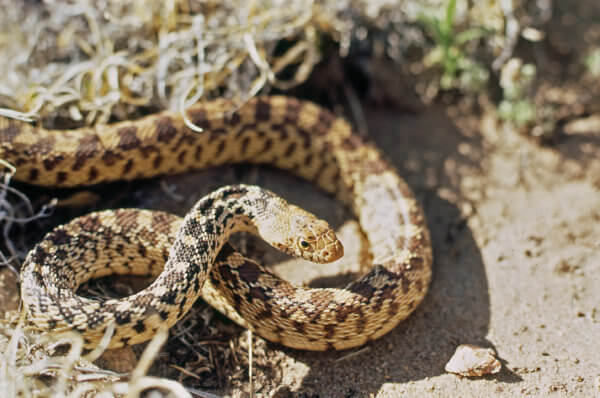Bull Snake Encounter
by Edward Monnig
Broadcast 10.9.2018

Bull snake (public domain image).
Listen:
One recent summer a group of friends and I floated the Middle Fork of the Salmon River in central Idaho. On this eight day trip we rafted 100 miles through some of the wildest country in North America: a 2.5 million-acre wildland officially called the Frank-Church-River-of-No-Return Wilderness Area, a wilderness whose name is as out-sized as the area itself.
One evening we were lounging under a large ponderosa pine recounting our day’s adventures when we noticed a 5-foot-long snake sprawled on a log on the other side of the tree. At first glance it looked a bit like a rattlesnake, but it lacked the pit viper’s triangular head and characteristic rattles. It was a non-poisonous bull snake or gopher snake, common to the western U.S.
We let the snake rest as we prepared dinner, and soon forgot about its presence. As we ate dinner, we noticed a couple of robins behaving rather oddly. They would hop in close to us, almost like the proverbial “camp robber” jays that have habituated to human food sources. We speculated that these robins had “gone bad” and had picked up the foraging habits of their jay cousins.
As it got dark, the birds became quite agitated and began buzzing the pine tree’s lowest branches, which were 15 feet above our heads. When we shined our flashlights into the tree, we were surprised to see the bull snake above us. The snake had climbed up the tree to the lowest branches by wedging itself in the furrowed bark of this old ponderosa. We watched as the snake cantilevered itself from branch to branch while the robins dive-attacked it, presumably in defense of a nest somewhere in the tree.
The drama continued as we turned in — although that night I decided to forgo my habit of sleeping under the stars. I have observed that the world is divided into two classes of people: those who delight in a physically cozy relationship with snakes and other reptiles; and the rest of us whose interest is, at best, intellectual.
The bull snake is also known as a gopher snake. The terms are used interchangeably in the official Montana state wildlife field guide. In an earlier Field Note, Jim Giese related some of the fascinating characteristics of this species. It is the largest snake in Montana, and its markings do bear a superficial resemblance to a rattlesnake. When threatened it enhances this resemblance by coiling like a rattlesnake and hissing. It may flatten its head to imitate the triangular appearance of a pit viper while shaking its tail in dry grass to mimic the sound of a rattle. Despite this flattery of imitation, bull snakes have been known to consume small rattlesnakes, and some sources report that bull snakes are immune to rattlesnake venom.
Like many snake species, bull snakes most commonly prey on various rodent species. They can also hunt bird nestlings. One researcher reported that over 20 percent of bluebird nest boxes in a California study area were preyed on by bull snakes. Predation on naturally placed nests, however, appears to be significantly lower.
The robins’ agitation was thus based on a well-founded concern about the bull snake’s hunting capabilities. Against large mammals, I will admit that bull snakes are woefully inadequate. Although I intellectually understood that, I still slept better inside a tent that night.
Every week since 1991, Field Notes has inquired about Montana’s natural history. Field Notes are written by naturalists, students, and listeners about the puzzle-tree bark, eagle talons, woolly aphids, and giant puffballs of Western, Central and Southwestern Montana and aired weekly on Montana Public Radio.
Click here to read and listen to more Field Notes. Field Notes is available as a podcast! Subscribe on iTunes, Google Play, or wherever you listen to podcasts.
Interested in writing a Field Note? Contact Allison De Jong, Field Notes editor, at adejong [at] montananaturalist [dot] org or 406.327.0405.
Want to learn more about our programs as well as fun natural history facts and seasonal phenology? Sign up for our e-newsletter! You can also become a member and get discounts on our programs as well as free reciprocal admission to 300+ science centers in North America!












